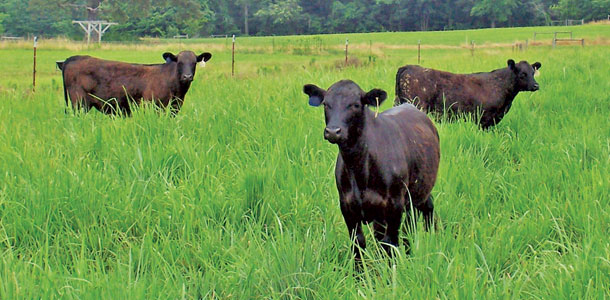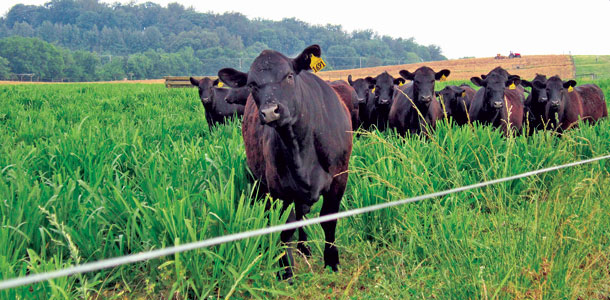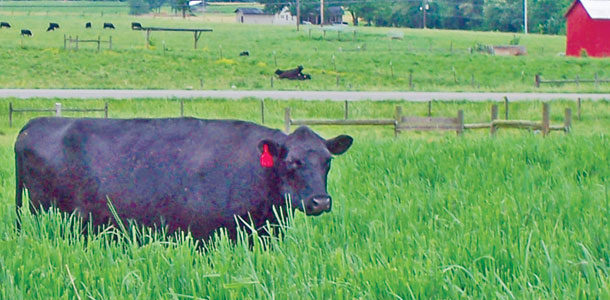Simply put, they are grasses that grow naturally in the eastern two-thirds of the U.S. and were not introduced from other parts of the world.
These tall, bunch grasses grow during summer, hence the label “warm-season.” While there are many species of such grasses, five of them have excellent potential as forages and are described briefly below.
Switchgrass
Switchgrass, because of its role in bioenergy, may be the most familiar of these grasses. Switchgrass is very productive in terms of tonnage and carrying capacity, is one of the most drought-tolerant and can grow on particularly wet sites.
There are two basic types of switchgrass – upland (more northerly adapted and shorter) and lowland (more southerly adapted and considerably taller).
In terms of forage quality, switchgrass can become stemmy, especially the lowland varieties, but it is readily grazed by cattle and produces strong summer gains, typically 1.5 to 2 pounds per day on steers.

Big bluestem
Big bluestem was the dominant species of the once vast tall-grass prairies. It is still common on native range and is probably the most preferred forage by cattle among the natives.
It does not produce quite as much tonnage as switchgrass but is less prone to stemminess and produces gains of 2 to 2.6 pounds per day on steers.
Big bluestem can grow on a wide variety of sites but does not do as well on wet sites as switchgrass does.
Little bluestem
Little bluestem, as its name suggests, is a much smaller relative of big bluestem. Of the five species mentioned here, it produces the least amount of forage but has the advantage of doing well on particularly poor sites, and compared to other native warm-season grasses, is easily established.
It is often planted in mixtures with big bluestem. Despite its similarity to broomsedge, it is a very good forage that cattle readily consume.
Indiangrass
Indiangrass commonly grows with both big and little bluestem on native rangeland. Compared to big bluestem, it is somewhat more productive (yield and carrying capacity), is slightly stemmier and is less tolerant of wet sites.
It can grow on a wide variety of soils, being intermediate between big and little bluestem in terms of its tolerance of poor soils.
It is an excellent forage, being only slightly less preferred than big bluestem. Like little bluestem, it is one of the easier native warm-season grasses to establish.

Eastern gamagrass
Eastern gamagrass is the least similar to the other native warm-season grasses described above. In terms of tonnage, it is comparable to switchgrass. In terms of site requirements, it can grow on sites as wet as switchgrass but may not do as well on thinner, poorer soils as the other native warm-season grasses.
Also, unlike the other native warm-season grasses, it is very responsive to nitrogen. Although readily consumed by cattle, it generally does not produce the high gains of the other species.
Nevertheless, it is highly drought-tolerant, can carry very high stocking rates and sustains production in late summer better than the others. It is also the earliest to grow in the spring.
So which of these should I grow?
If you are interested in improving summer forage production and want remarkable drought tolerance with low fertilizer demands (about 60 pounds nitrogen per acre under grazing), then you should consider any of the native warm-season grasses. However, each has its strengths and weaknesses.
Let’s first consider site. As mentioned above, on very wet sites, you should plant either a lowland switchgrass or eastern gamagrass.
On poor sites, little bluestem, indiangrass or switchgrass – in that order – should be planted; avoid use of eastern gamagrass on such sites.
Big and little bluestem and indiangrass can all work well in a mixture, but switchgrass and eastern gamagrass mature earlier and are less preferred, and as a result, are typically planted by themselves.
Second, consider your objectives. If you want a very drought-tolerant pasture, and making high rates of gain is not important, eastern gamagrass is a good choice.
If you have easy access to poultry litter, municipal sludge or other forms of less-expensive nitrogen, eastern gamagrass can be a good option.
I have spoken to cow-calf producers who have relied on relatively small eastern gamagrass pastures to sustain their herds during some of the severe droughts of the past six or seven years.
While gains may not have been impressive, the ability of this grass to handle very high stocking during very dry periods made a big difference for these operations.
On the other hand, if high stocking rates are less important, and you need high rates of gain, big bluestem or indiangrass, or a blend of these two and perhaps little bluestem, are an excellent choice.
Backgrounding fall steers for 30, 60 or even 100 days on these grasses can put a lot of pounds on the truck that comes back to the producer’s pocket.
Similarly, for heifer development, studies at the University of Tennessee have demonstrated gains of 1.5 to 1.8 pounds per day on 10-weight bred heifers. Those are ideal gains for this class of animal.
Although switchgrass falls between the two options mentioned above, it may be the best overall choice. It can produce gains in excess of 2.0 pounds per day for steers early in the season but can also withstand very high stocking,
if needed. Switchgrass may also be one of the most flexible of the native warm-season grasses in terms of site adaptation. However, its rapid growth in May and June, ability to quickly get stemmy during June and July and its slower growth in late summer all make it a bit harder to manage properly than the other native warm-season grasses.
Regardless of which native warm-season grass you choose, you need to be prepared to pay attention to detail to successfully establish these perennial grasses.
You will also need to manage grazing of native warm-season grasses to ensure adequate residual heights or rest between rotations – important considerations for any tall-growing grass.
Native grasses can all provide a low-input summer forage option that will substantially improve the drought tolerance of your overall forage program. FG
PHOTOSPHOTO 1: Switchgrass.
PHOTO 2: Big bluestem pasture.
PHOTO 3: Eastern gammagrass. Photos courtesy of Patrick Keyser.

Patrick Keyser
Professor and Director
Center for Native Grasslands Management










